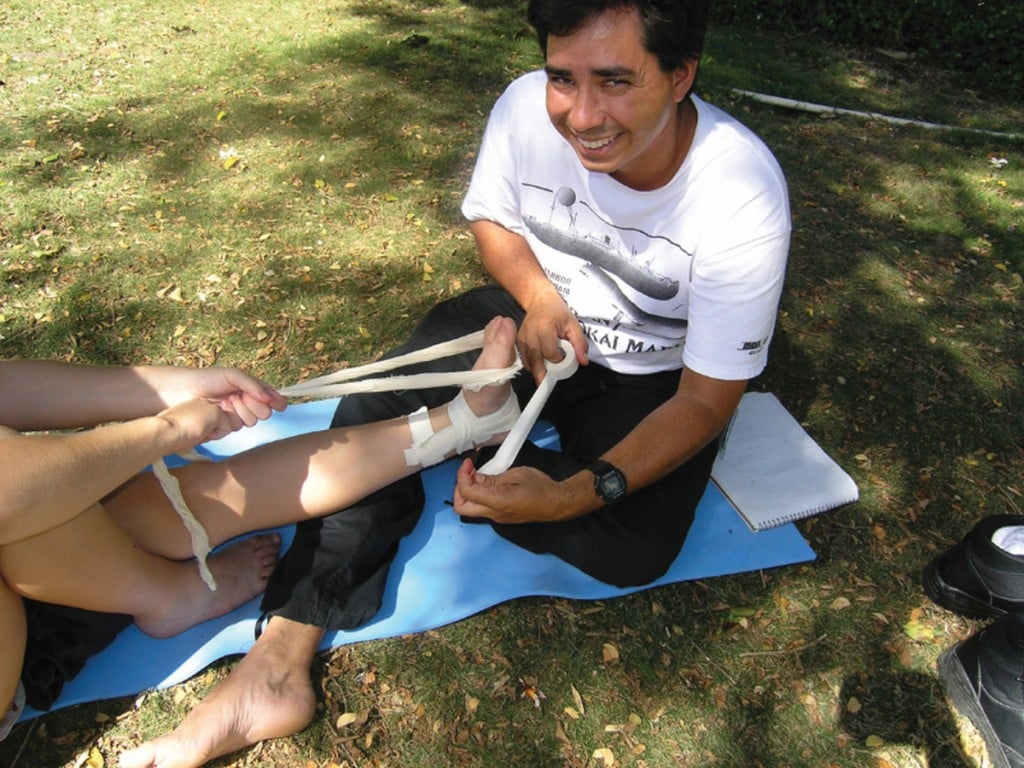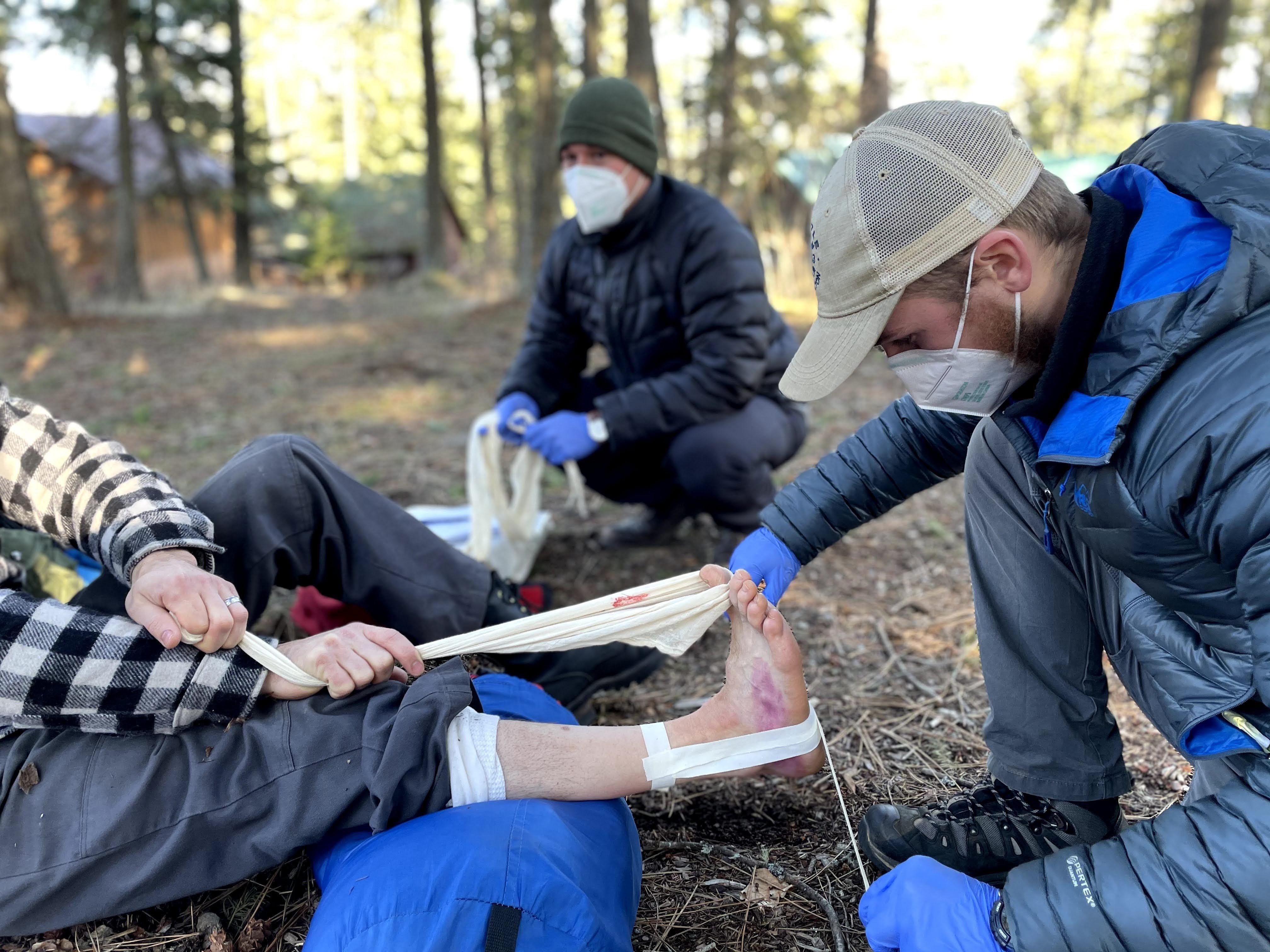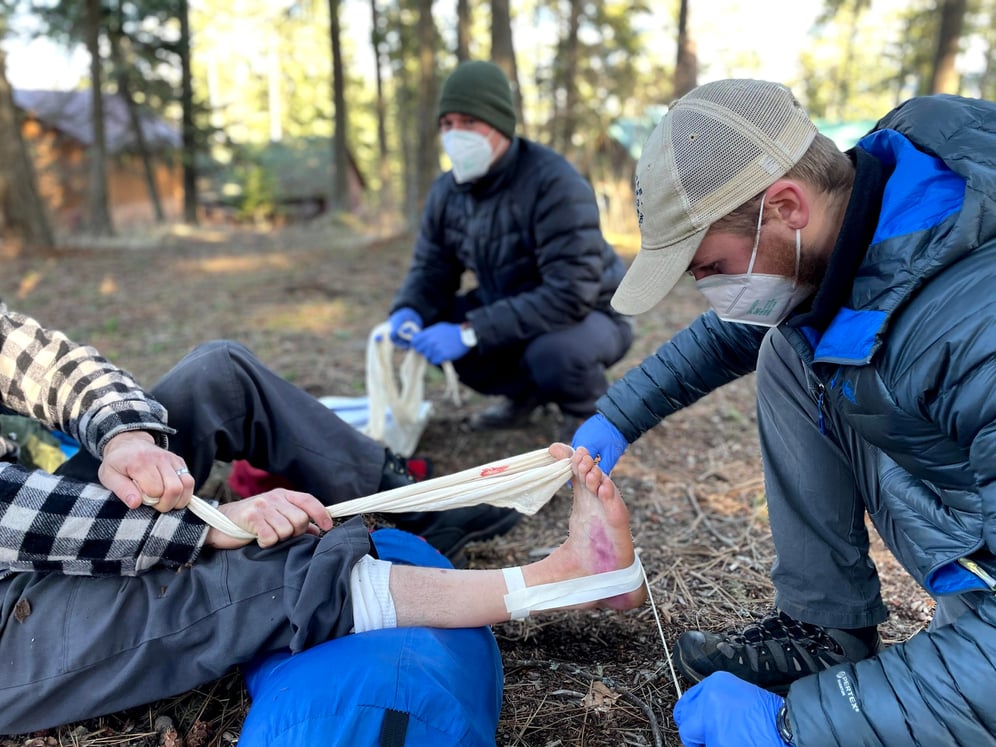After a long day day of hiking, you walk down to the lake to fill up your pot to start cooking dinner. Then, suddenly—you slip. Your ankle twists and you land hard on your butt. As you sit up, you’re relieved to discover that nothing really hurts except your ankle. And then you start to worry.

Practicing good first aid skills for the backcountry. Photo by Shana Tarter.
Is it broken? Is it sprained? Is this a trip-ending injury?
In the backcountry, it’s not practical or possible to diagnose an athletic injury like this. What you can do, however, is determine whether an injury is usable or not. If the limb is usable, you can take care of it with some of the treatments we'll outline below. If the limb is unusable, then you must immobilize it and evacuate.
Athletic injuries, including strains and sprains, are some of the most common injuries encountered in the backcountry. Sprains are injuries to ligaments, the tissues that connect two bones, and strains are injuries to muscles and tendons. This is what you usually think of as a “pulled” muscle.
Here are some common causes of athletic injuries:
- Tripping while walking in camp
- Stepping over logs
- Crossing streams, including shallow rock hops
- Putting on a backpack
- Lifting a kayak or raft
- Falling or misstepping while hiking with a pack on any terrain
- Shoveling snow
- Evaluate the mechanism of injury. How did the patient get hurt? Did the pain come on suddenly, perhaps from a fall, indicating a sprain, or did it get progressively worse, indicating an overuse injury?
- Evaluate signs and symptoms (see more details below).
- Perform a usability test. Ask the patient to try to move the joint through its full range of motion. Painless movement is a good sign. If the patient is able to use or bear weight on the affected limb, and pain and swelling are not severe, he or she may be treated in the field.
Signs and Symptoms of Athletic Injuries
- Swelling and discoloration
- Pain or tenderness
- Instability and/or loss of range of motion
- Inability to bear weight
- Point tenderness and obvious deformity (suggests a fracture)
- Severe pain, the sound of a pop at the time of injury, immediate swelling, and inability to use the joint are signs of a serious sprain, possibly a fracture. This injury should be immobilized and the patient evacuated from the field.
Once you've determined whether an injury is usable or not, you can start your treatment.
Treating Ankle Sprains
The key treatment principles for athletic injuries like sprained ankles are pain management and support using tape, braces, or splints, as in the video below.
To manage pain, you can use ice in the short-term (although long-term use of ice to suppress swelling isn't advised since it likely interferes with healing). Over-the-counter medications, such as acetaminophen and ibuprofen, are also useful pain management tools.
Elevating the injured ankle can reduce throbbing and allow for easier sleep.
Prevention
- Warm up before exercise and don’t do too much too quickly. Overuse, errors in technique (such as paddle strokes), and inadequate muscular conditioning or warm-up commonly cause athletic injuries.
- Take care in steep terrain and wet conditions, as you are more likely to slip when it’s slippery (naturally). Be aware that you’re almost as likely to fall in camp as on the trail
- You are more likely to be injured when you are tired, cold, dehydrated, rushed or ill, since you aren’t thinking as clearly and your muscles are less flexible and responsive.
- Injuries happen more frequently in the late morning and late afternoon when dehydration and fatigue reduce awareness and increase clumsiness. Shifting from a three-meal-a-day schedule to eating breakfast and dinner plus three or four light snacks during the day helps keep your energy supply constant.
- Haste, often the result of unrealistic timetables, is frequently implicated in accidents. Try to negotiate more difficult terrain in the morning, when you’re fresh. Take rest breaks before difficult sections of a hike or paddle. Drink, eat, and stretch tight muscles. Check equipment for loose gear that may trip you and for poorly balanced backpacks.
- Start doing physical conditioning before you get to the wilderness so you’re ready for the physical demands of your trip.
Evacuation Guidelines
Evacuation decisions on athletic injuries are usually based on practical considerations: continued pain, an injury that does not heal, or inability to travel.




